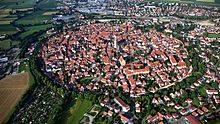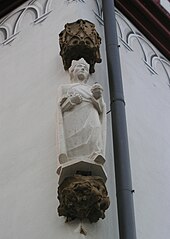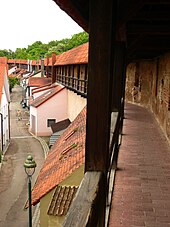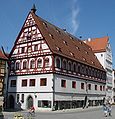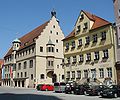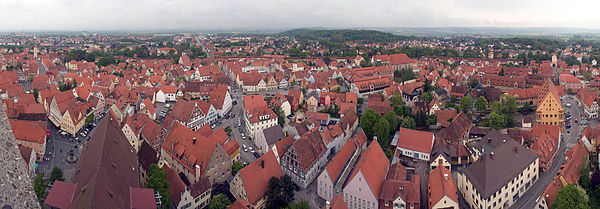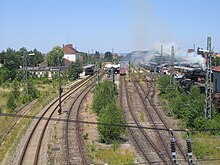Nordlingen
| coat of arms | Germany map | |
|---|---|---|

|
Coordinates: 48 ° 51 ' N , 10 ° 29' E |
|
| Basic data | ||
| State : | Bavaria | |
| Administrative region : | Swabia | |
| County : | Danube Ries | |
| Height : | 441 m above sea level NHN | |
| Area : | 68.1 km 2 | |
| Residents: | 20,546 (Dec. 31, 2019) | |
| Population density : | 302 inhabitants per km 2 | |
| Postal code : | 86720 | |
| Area code : | 09081 | |
| License plate : | DON, Lower Austria | |
| Community key : | 09 7 79 194 | |
| City structure: | 17 parts of the community | |
City administration address : |
Marktplatz 1 86720 Nördlingen |
|
| Website : | ||
| Lord Mayor : | David Wittner ( PWG ) | |
| Location of the city of Nördlingen in the Donau-Ries district | ||
Nördlingen (Rieser-Schwäbisch Nearle ) is a large district town in the Swabian district of Donau-Ries in Bavaria . It is the largest city in the district.
From the city elevation in 1215 by the Staufer King Friedrich II. Nördlingen was an independent imperial city in the Holy Roman Empire until mediatization in 1802 , which is reflected in the city coat of arms.
geography
Nördlingen is located in the Nördlinger Ries , the impact crater of a meteorite that struck the Alb 15 million years ago. The crater has a diameter of 23 to 25 kilometers; its edge is visible all around as a chain of hills. Through the scientific research of the Ries event , Nördlingen became known worldwide. The ream of the Wörnitz and the Eger flows through; the former flows into the Danube 30 kilometers southeast .
Parish parts
The municipality has 17 officially named municipal parts (the type of settlement is given in brackets ):
|
|
|
City structure
The Nördlinger core city is roughly divided into the old town, Graben, Wemdinger Viertel, Saubrunnen, Augsburger Viertel, Talbreite, Herkheimer Viertel and South Tyrolean district. The parts of the municipality Baldingen and Kleinerdlingen flow almost smoothly into the city center, while the remaining parts of the municipality have retained the character of closed villages.
Neighboring communities
The following communities border the city of Nördlingen: Wallerstein , Maihingen , Oettingen , Munningen , Wechingen , Deiningen , Alerheim , Möttingen , Reimlingen , Hohenaltheim , Ederheim , Neresheim , Bopfingen , Riesbürg .
Land use
| Area and land use | |
|---|---|
| total area | 6810 ha |
| Agricultural area | 5418 ha |
| Building and open space | 591 ha |
| traffic area | 529 ha |
history
Pre-Roman times and antiquity
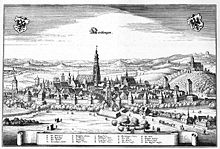

Finds in the Ofnet caves show that today's local area of Nördlingen was already settled in the late Paleolithic . In the districts of Nördlingen, sites from almost all of the following prehistoric epochs have been discovered. An area on the eastern edge of the Baldingen part of the municipality was particularly densely populated, where settlements of the band ceramics and the early Neolithic , the Urnfield culture , the Hallstatt and Latène times were discovered. There was also a Roman villa with a cremation burial site.
Around the year 85 AD, a Roman fort with a settlement ( vicus ) was built in the south of the city , which was lost in the years 259/260 when the Alamanni conquered what is now southern Germany . The name of this settlement was probably Septemiacum . This Latin place name has been reliably passed down through the Peutinger table ( Tabula Peutingeriana ) for the area of Nördlingen, but so far it cannot be reliably assigned to the Roman settlement in present-day Nördlingen. A Roman manor ( villa rustica ) was excavated in the Holheim district and can be visited. The Roman Nördlingen has so far hardly been explored.
Middle Ages and early modern times
Alemannic settlement can be proven in the 6th and 7th centuries . Three row grave cemeteries from this era have so far been excavated in Nördlingen.
"Nordilinga" was mentioned for the first time in 898 as a Carolingian royal court. Under the rule of the Bishop of Regensburg , Nördlingen grew into a market .
Imperial city
In 1215 Nördlingen received city rights from King Friedrich II and became an imperial city. In that year the first city wall was built, the floor plan of which is still visible today. The Nördlinger Whitsun Mass was first mentioned in a document in 1219 . The city, located at the intersection of two major trade routes (Frankfurt / Würzburg-Augsburg and Nuremberg-Ulm), became an important trading center for grain, cattle, textiles, furs and metal goods. In addition to Frankfurt, Nördlingen was one of the most important long-distance trade fairs in Germany. In the great freedom letter dated November 8, 1219, Frederick II granted the city of Nuremberg - as it were as an economic promotion and individual case determination - the right to maintain their own exchange table at the trade fairs in Nördlingen and Donauwörth, to buy gold and silver with Nuremberg pennies and to use the To turn Nuremberg mint master into money; there was already a coin in place .
In 1238 a fire destroyed a large part of the city, from which it quickly recovered. Nördlingen is mentioned in the imperial tax register of 1241 with a payment of 100 silver marks . Three generations later, a large number of craftsmen, mostly tanners and weavers, had settled outside the city walls. In 1327 the still existing wall ring was built, with which the walled city area increased fourfold. In 1427 construction began on St. George's Church.
For the year 1472 the proceedings against the city 's landlord Linhardt Freiermuth and his wife Barbara Taschenfeind are recorded in the city 's court files. The starting point of the hearing was the charge of the forced abortion of the prostitute Els von Eystett. The court found the pimp couple guilty and banished the woman innkeeper from the city. His wife was branded on the forehead and pilloried . The 40 parchment pages for this court hearing in the city archive of Nördlingen give a unique insight into the condition of a brothel belonging to the city at that time .
In 1529 the city belonged to the representatives of the Protestant minority ( Protestation ) at the Reichstag in Speyer . Their citizenship demanded the unhindered expansion of the Protestant denomination. In 1555 the Reformation in Nördlingen was finally confirmed. Mayor Peter Seng the Elder Ä. (1512–1589) signed the Lutheran formula of 1577 for the city council in 1579 .
Witch hunts
The history of the witch hunt in Nördlingen is well documented. Between 1590 and 1598, 34 women and one man were executed at the stake for witchcraft between 1590 and 1598 during the term of office of Mayor Johannes Pferdinger; The witch trials against Rebekka Lemp († 1590) and Maria Holl , who was released from prison in 1594, became particularly well known .
The wave of persecution began with the assumption of office by Mayor Johannes Pferdeinger (around 1533-1604) in November 1589. He was at his witch trials by the newly appointed councilor Wolfgang Graf († 1608) and Sebastian Röttinger (1537-1608) and the town clerk Paul Maier († 1590) supported. The Nördlinger Superintendent Wilhelm Friedrich Lutz (1551–1597) was an avowed opponent of the persecution of witches and already in December 1589 gave two sharp sermons against the actions of the council. The council forbade him to interfere in worldly affairs and prevailed.
Ursula Haider was the first to be arrested on November 8, 1589. The socially isolated, single woman had publicly fantasized about a love affair with the devil and accused herself of child murder. During the interrogation, she accused nine other women in the city, who were also arrested and interrogated. Two of them, Margarethe Getzler and Maria Marb, were the first to be burned in public for witchcraft on May 15, 1590, together with Ursula Haider . During their interrogations, they gave the other names, which led to further arrests and trials, these in turn to new names, etc. During the second witch burning in Nördlingen on July 10, 1590, three women were executed again : the mentally confused Apollonia Aißlinger, the wealthy Anna Koch and the councilor widow Maria Schöpperlin. The third witch burning with five victims took place on September 9, 1590. The victims were: Anna Seng, the wife of the town hall administrator Margarethe Frickinger, Margaretha Hummel, the wife of the paymaster Rebekka Lemp and the wealthy mayor's widow Barbara Wörlin. The midwife Barbara Lierheimer had already died in custody on July 23, 1590.
The convicts were burned at the execution site on Galgenberg. Since this was not yet forested at that time, the fires could be seen all over the Ries.
Thirty Years War and the aftermath
A historic turning point in the Thirty Years' War were the siege of Nördlingen and the subsequent Battle of Nördlingen in 1634, in the Swedish-Protestant forces first critical of the imperial - Habsburg were beaten troops. The city had to open up to the victors, but was not plundered by the victorious troops after high reparation payments. However, the city lost more than half of its population during and after the siege due to hunger and disease. During the War of the Spanish Succession , the city was also affected by the effects of the nearby battles of Höchstädt .
After the war, trade shifted to the seaports - another reason why Nördlingen lost its importance as a trading center. Due to the forced standstill, the medieval townscape was well preserved.
There were often conflicts over sovereign rights with the county of Oettingen , whose enclave was Nördlingen. From the 16th to the beginning of the 18th century, Nördlingen filed 103 complaints in this regard before the Reich Chamber of Commerce .
Mediatization until today
In the course of the Napoleonic reorganization of Germany, Nördlingen lost its status as an imperial city in the Reichsdeputationshauptschluss 1803 and fell to the Electorate of Bavaria , which, in anticipation of the conditions already negotiated, had occupied the city in September 1802 and implemented its administrative integration. On January 1, 1806, the city became a royal Bavarian country town in accordance with the prince's rise in rank in the Peace of Pressburg .
On May 15, 1849 Nördlingen was connected to the network of the Royal Bavarian State Railways with the commissioning of the section of the Ludwig-Süd-Nord-Bahn from Donauwörth . In the same year the other sections to Nuremberg were opened. The third railway connection under the leadership of the Royal Württemberg State Railways was opened on October 3, 1863 with the line to Aalen as the second part of the then Remsbahn . This made Nördlingen the second border station to the Kingdom of Württemberg after Ulm .
Jewish families had lived in Nördlingen since the Middle Ages, buried their dead in the Jewish cemetery on Nähermemminger Weg and built their new synagogue in Kreuzgasse 1 in 1885 . This church was devastated by SA men during the November pogrom in 1938 , as a memorial plaque on today's Evangelical parish hall reminds of. Since 1979, a memorial stone in the Jewish cemetery has been commemorating the Jewish citizens who were victims of the Shoah .
Only in 1939 did Nördlingen regain the population of 1618.
A total of 33 people were killed in air raids towards the end of the Second World War in the spring of 1945. The train station and several residential buildings were destroyed, and St. George's Church was badly damaged. Most of the rest of the historic old town was spared.
From 1945 Nördlingen belonged to the American zone of occupation . The American military administration set up a DP camp to accommodate so-called Displaced Persons (DP). The camp was managed by UNRRA and housed around 500 DPs. Most of them were from Latvia and Lithuania .
More than 4,500 displaced persons settled in Nördlingen after the war.
In the course of the municipal reorganization of Bavaria , Nördlingen lost its status as an independent city on July 1, 1972 and was incorporated into the newly formed Nördlingen-Donauwörth district, which was given the current name of Donau-Ries district on May 1, 1973 .
Incorporations
On July 1, 1972, the previously independent communities of Herkheim, Holheim, Kleinerdlingen and Nähermemmingen were incorporated. Löpsingen was added on January 1, 1973. Großelfingen (spelling at that time) and Pfäfflingen followed on January 1, 1976. The series of incorporations was completed with the incorporation of Schmähingen on January 1, 1978 and Baldingen and Dürrenzimmern on May 1, 1978.
Population development
Between 1988 and 2018 the city grew from 18,278 to 20,379 by 2,101 inhabitants or by 11.5%.
religion
- Nördlingen, which introduced the Reformation in 1522 ( Kaspar Kantz , Theobald Billicanus ), is the seat of the Evangelical Lutheran Dean's Office Nördlingen in the Augsburg parish of the Evangelical Regional Church of Bavaria .
- The Catholic deanery Nördlingen belongs to the diocese of Augsburg .
politics
City council
The city council consists of 30 members (2014: 24), whose seats have been divided as follows since the local elections on March 15, 2020 according to the proportion of votes:
| Party / group | Share of votes | Seats | G / V |
|---|---|---|---|
| CSU | 27.21% | 8th | + 1 |
| District list | 20.88% | 6th | ± 0 |
| PWG (non-party voter community) | 20.09% | 6th | + 2 |
| Alliance 90 / Greens * | 13.82% | 4th | + 1 |
| SPD | 11.87% | 4th | + 1 |
| Nördlinger women list * | 5.05% | 2 | + 1 |
P / L: gain or loss compared to the 2014 election
* Greens and women lists together form a parliamentary group .
mayor
| Surname | Political party | function | Term of office |
|---|---|---|---|
| Daniel Eberhart Dolp | First Mayor | 1761-1771 | |
| Georg Christian Freiherr von Troeltsch | First Mayor | 1771-1804 | |
| Georg Friedrich Cramer | First Mayor | 1804-1818 | |
| Christian Schröpel | First Mayor | 1818-1831 | |
| Friedrich Wilhelm Doppelmayr | First Mayor | 1831-1845 | |
| Adolf Liederer von Linderskorn | First Mayor | 1845-1848 | |
| Karl Brater | First Mayor | 1848-1851 | |
| August Emil Luthardt | First Mayor | 1851-1854 | |
| Wilhelm Erhard | First Mayor | 1854-1862 | |
| Christoph Bauer | First Mayor | 1862-1865 | |
| Johannes von Teubern | First Mayor | 1865-1871 | |
| Balthasar Ritter von Reiger | National Liberal Party | First Mayor | 1871-1913 |
| Wilhelm Brunco | First Mayor | 1914-1916 | |
| Otto Mainer | National Liberal Party | First Mayor | 1916-1927 |
| Wilhelm Hausmann | DNVP, from 1933 NSDAP | First Mayor | 1927-1939 |
| Heinrich Schulz | NSDAP | Commissioner. mayor | 1939-1941 |
| Eugen Einberger | NSDAP | Commissioner. mayor | 1941-1944 |
| Paul Mercenary | First Mayor | 1945-1946 | |
| Josef Feil | First Mayor | 1946-1948 | |
| Johannes Weinberger | SPD | Lord Mayor | 1948-1964 |
| Hermann Keßler | CSU | Lord Mayor | 1964-1982 |
| Paul Kling | CSU | Lord Mayor | 1982-2006 |
| Hermann Faul | PWG | Lord Mayor | 2006-2020 |
| David Wittner | PWG | Lord Mayor | since 2020 |
Town twinning
- since 1967: Wagga Wagga , New South Wales , Australia

- since 1970: Riom , Auvergne-Rhône-Alpes , France

- since 1991: Stollberg / Erzgeb. , Saxony , Germany

- since 2001: Markham , Ontario , Canada

- since 2008: Olomouc , Olomoucký kraj , Czech Republic

Sponsorship
- In 1951 the sponsorship for the expelled Sudeten Germans from the city and the district of Tetschen-Bodenbach was taken over.
- In 1976 the sponsorship for the expelled Germans from the city of Olomouc was taken over.
City arms
| Blazon : "In gold a red-tongued, gold-armored and crowned black (Staufer-imperial city) eagle ." | |
Culture and sights
Buildings
city wall
The completely preserved city wall from 1327 has five gates with gate towers, eleven other towers and two bastions .
The largest city gate is the Berger Tor in the south. Clockwise follows the Baldinger Tor in the west, the Löpsinger Tor, which also houses the City Wall Museum, in the north, the Deininger Tor in the northeast and the Reimlinger Tor in the east. The towers are clockwise filing tower, lion tower, upper water tower, oven towers (5), pointed tower, lower water tower and tear tower. The old bastion, which can accommodate ten guns on two floors, has been completely preserved. The New Bastion, however, was demolished in 1808–1826.
The Nördlinger city wall is 2.6 km long and one of the best preserved in Germany. Its battlement is completely accessible, so that the whole city can be circled in this way.
Churches
The landmark of Nördlingen is the around 90 meter high steeple of the Gothic St. George's Church , which was built between 1427 and 1505 and is called Daniel . The Catholic St. Salvator Church on the southwestern edge of the city center is also worth seeing . The neo-Gothic cemetery church of St. Emmeram was built between 1874 and 1875, but dates back to Nördlingen's first church from the 9th century. The hospital church was built in the 13th century as part of the Heilig-Geist-Spital . The New Apostolic Church on Gartenstrasse was moved into in 1954. The parish church of St. Josef was built between 1960 and 1962.
Marketplace
Immediately to the north of St. George's Church is the market square, where the trade fair audience romped around for ten days every year in the Middle Ages. The cloth merchants presented their goods in the bread and dance house built between 1442 and 1444, the upper floor of which served as a ballroom. Connected to it by a bridge was the Metzig half-timbered house, built in 1363, which housed the butchers' stalls on normal days and served as an extension of the sales area during trade fairs. To the north is the high house, which was mentioned in a document in 1304.
The Gasthaus zur Sonne on the opposite side was built in 1350 and has been used as a royal inn since 1405. Around 1500 the emperors Friedrich III stayed there . and Maximilian I. , 1548 Karl V. In 1788 Johann Wolfgang von Goethe was a guest and in 1970 the American astronauts of the Apollo moon travel program took up quarters there.
To the north is the town hall. Like St. George's Church and many other townhouses, it is built from the porous suevite stone from the Nördlinger Ries. It is documented in a sales deed as early as 1313; at that time it was used as a trade fair store. In 1382 the city rented the building and has been using it as a town hall ever since. Around 1500 the upper floor with its stepped gable and the gable bay window was placed on top of the building, in 1509 the treasure tower and in 1618 the representative Renaissance staircase was added. Inside the large assembly room, where the members of the Swabian Federation met in the 16th century , there is a large, valuable wall fresco by Hans Schäufelin .
Old town
The entire old town of Nördlingen is home to an abundance of lovingly renovated, magnificent houses from the Middle Ages and the Renaissance.
A few steps northwest of the market square you get to the Tändelmarkt and the associated port market via Eisengasse. In the Eisengasse, which is named after the iron merchants who previously settled there, the Schneidtsche House, built in 1563, is noteworthy. During the Thirty Years War it served Gustav II Adolf as accommodation for two days in September 1632. At the Hafenmarkt is the Kaisheimer Haus, from 1278 to 1802 a box house belonging to the Kaisheim Imperial Monastery . The Hafenhaus, a splendid former department store from 1425, stood there until a fire on May 3, 1955.
On the northwest corner of the Tändelmarkt, the big Klösterle catches the eye, a former Franciscan monastery. In the course of the Reformation, the monastery became more and more orphaned. The city bought the building in 1536 and had it converted into a granary in 1584–1587. The choir was torn down and replaced by today's spacious stepped gable.
The tanner quarter adjoining it to the west houses a number of the typical tanner houses with their half-timbered houses and their large, cantilevered drying floors and galleries on the upper floors. The Egerkanal, which runs through the district, covered the large water needs of the tanners. At the bridge at the northern end of the district is the large, undershot water wheel of the Neumühle.
The Heilig-Geist-Spital , founded around 1233 , used to serve as a supply center for the elderly and poor. Like many similar institutions of the time, it was funded and expanded by foundations. The hospital church from the 13th century houses valuable wall paintings from the 14th century. Today the city museum is located in its two main buildings from the 15th and 16th centuries .
In the southern area of the old town, the Wintersche Haus, built in 1697, is remarkable. The large, well-proportioned half-timbered building has a stylish garden at its rear with flower galleries on the first and second floors. At the Weinmarkt there are a number of representative town houses and the large, massive looking hall building, built between 1541 and 1543. It once served as the city's salt and wine warehouse. The former Gasthaus zur Krone, whose landlady Maria Holl became famous through the witch trials, is also located on the Weinmarkt .
A number of remarkable town houses are located in the Polizeigasse, which connects the Weinmarkt with the market square. These include the Alte Post, the Mötzelsche Haus, which was inhabited by the Oelhafen family in the 15th century , and the Einhorn-Apotheke.
To the east of the Georgskirche, on the beet market, stands the Kriegerbrunnen , an Art Nouveau building that was created in 1902 by Georg Wrba in memory of the Franco-Prussian War of 1870/71.
The city moat is designed as a park with sculptures, exotic trees and a rose garden (rosarium) in the area of the Frickhinger facilities , between Ochsenzwinger and Berger Tor.
Architectural monuments
Marienhöhe
The forest area in the south of the old town covers the Galgenberg and the Stoffelsberg and is named after Marie Friederike von Prussia . The originally bare hills were planted with trees for the first time in 1834 and have been gradually designed as a landscape park since then. The witch's rock on the Galgenberg was a municipal execution site at the time of the witch hunt (1590–1598) . The first beer cellar was built on Marienhöhe in 1817 . The three beer cellars that still exist there today are popular excursion destinations. The Nördlinger open-air swimming pool extends on the southern slope of the Marienhöhe . The Nördlinger Kreisklinik, the “foundation hospital”, is also located at Marienhöhe. The Kellermannsweg, an avenue of lime trees with 60 trees that were planted in 1906, leads from the old town to Marienhöhe.
Museums
- The Ries Crater Museum offers interesting visual material about the geological development of the area and a simulation of the Ries impact around 15 million years ago, when the Nördlinger Ries was created. In addition, real moon rocks can be viewed there , which the city of Nördlingen received as a permanent loan from NASA . In 1970 she trained the astronauts of the Apollo 14 mission in Ries. The Suevite -Gestein in the quarries in the Ries similar to the rocks on the lunar surface. It contains minerals that are only formed under the extreme pressure and temperature conditions that occur during meteorite impacts .
- The City Museum Nördlingen gives an insight into the history of the imperial city of Nördlingen and the settlement history of the Nördlinger Ries . It houses panel paintings by Friedrich Herlin , Hans Schäufelin and Sebastian Taig . The skull finds from the Ofnet caves can also be seen there.
- The city wall museum on the six floors of the Löpsinger gate tower documents the history of the Nördlingen city wall. A tin figure model of the battle of Nördlingen and a model of the entire old town can be seen there.
- The Bavarian Railway Museum houses more than two hundred original exhibits, including the oldest operational standard-gauge steam locomotive in Germany.
- The augenblick - Museum for optical and acoustic attractions shows exhibits from the beginnings of the media age: peep boxes, panoramas, magic lantern, barrel organs, automatic pianos, music boxes and gramophones.
- The Thiemig Gallery in Weilbachhaus showed a permanent exhibition of framed reproductions by famous painters. It was set up by the publisher Günther Thiemig, who died in 1991, in the former Pfisterei of the Spitalhof. Works by Giotto, Tizian, Raffael, Dürer, Rubens, Goya, Macke, Marc and Kandinsky could be seen. In 2012 the exhibition was closed.
theatre
The drama factory in Nördlingen is a privately run drama theater without its own ensemble with 99 seats. The open-air theater of the old bastion in a medieval bastion is the scene of historical and contemporary performances by the amateur theater group Verein Alt Nördlingen every summer. The Dramatic Ensemble Nördlingen is an independent and regionally renowned theater project. During the winter season, touring theaters regularly perform in the Klösterle city hall. Cabaret events take place in the Ochsenzwinger cultural center.
Nördlingen gained theatrical significance when, in 1604, one of the first Shakespeare performances outside of England took place there with a shortened and simplified version of Romeo and Juliet .
music
The Nördlingen Boys' Chapel, founded in 1924, is one of the well-known youth wind orchestras in southern Germany. The young musicians are on tour around the world and regularly give music for international football matches and state visits. The city chapel was founded in 1990. The Rieser Music School offers early musical education and instrumental lessons. Numerous choirs (including St. Georg Choir), classical and jazz ensembles are registered as associations in Nördlingen. Well-known chamber music ensembles appear in the winter concert series of the Raiffeisen-Volksbank Ries . The Nördlinger Kneiptour has been taking place every spring since 1996 with performances by numerous rock, pop and jazz bands in Nördlinger pubs.
movie theater
Nördlingen has two cinemas: Movieworld Nördlingen with four halls and the Ries Theater in the old town with two halls.
Modern art
The Kunstverein Nördlingen was founded in July 2001 with the aim of promoting the visual arts, artists and a general understanding of national and international art. Several times a year it organizes various exhibitions, lectures and excursions, supplemented by exhibition didactic offers. In 2006, 2011 and 2012 he organized illuminations of various historical buildings in the city. In 2012 the Kunstverein Nördlingen moved into its new premises in the post office building, as an incubator and nucleus in the center of the “art space at the train station”. 2013 was marked by the enthusiasm of young people for modern art and the exhibition Punk Rock - Young Art as a guest at the Kunstverein Nördlingen .
Events
- Every three years you can visit the historical city wall festival of the former imperial city in Nördlingen . In addition to old handicrafts, knight and equestrian games from the Middle Ages can be seen.
- The Stabenfest (first named in a document in 1690), which is supposed to welcome spring, goes back to the year 1406 (first mentioned as "Rayetag" in the city chamber arithmetic book) and is the oldest children's festival in Germany. It is celebrated every year on the Monday after Mother's Day with a parade for all Nördlingen schoolchildren who have decorated themselves with the city flags, flowers and birch branches.
- Every year on the second Saturday after Whitsun, the Nördlinger Whitsun Mass begins with a parade. It lasts ten days and includes a consumer fair and an amusement park.
- The Christmas market, which is open daily, begins on the Friday before the First Advent.
- The scarlet race takes place in Nördlingen in summer . This international horse show dates back to 1438.
- Annual events in the old town are the craft market, pottery market, rose market, spring market, September market and autumn market as well as the flea market for everyone in August, which according to the city administration is one of the largest markets in Bavaria.
sport and freetime
sports clubs
- The TSV 1861 Nördlingen is the largest membership sports club in Nördlingen. It offers a wide variety of sports, including badminton, basketball, fencing, soccer, handball, judo / ju-jutsu, athletics, rugby, table tennis, gymnastics and volleyball.
- The BG Donau-Ries was founded in 2008 and plays in the 1st women's basketball league .
- The football club SC Athletik Nördlingen, founded in 1984, is best known for its women's football teams. The association has around 300 members. He organizes maypole celebrations at the Brettermarkt and maintains his own warehouse at the city wall festival.
- The Rieser Ski- and Snowboardclub Nördlingen offers ski trips in the winter months. A ski and snowboard school is connected, which organizes courses with its own team of teachers. Courses for fitness and ski gymnastics are also offered.
- The tennis club “Rot-Weiß” Nördlingen e. V. celebrated its centenary in 2002. The club has a total of ten clay courts at the foot of the Marienhöhe. The club house, which was inaugurated in 2007, is also located there.
Leisure and sports facilities
The Rieser Sportpark is a park-like facility. In the center is the athletics stadium (Gerd Müller Stadium) with a capacity of approx. 10,000 spectators and several alternative and training areas. At the same time, it is also the home stadium of TSV Nördlingen footballers. In addition, the Hermann-Keßler-Halle is another central facility in the Rieser Sportpark. It is set up as a quadruple hall and has been able to accommodate up to 3,000 spectators for home games of the Nördlinger basketball players (Giants Nördlingen) since its capacity was expanded in 2008. There are several clay courts and three indoor courts available for tennis players. There is also an airfield for motor and glider flights in Nördlingen. According to the city administration, the ice rink at Bäumlesgraben is one of the largest natural ice rinks in southern Germany.
The solar bath is located on the southern slope of the Marienhöhe - an outdoor pool that was rebuilt in 1995. Swimming pool absorbers and a photovoltaic system are installed on the roofs . The municipal indoor pool is on Gerhart-Hauptmann-Strasse.
In the city area, two fitness studios offer the opportunity for strength and endurance training.
Youth work
The city of Nördlingen supports the non-profit meeting place of Jugend Nördlingen e. V. It makes the premises of the former municipal calibration office in Lerchenstrasse available to the association that takes care of open youth work. The association is committed to B. in cooperation with the Diakonisches Werk Nördlingen and other volunteer helpers in an integration project for repatriates from Russia.
Cittaslow
Nördlingen was one of the few cities in Germany to be accepted into the Cittàslow slow food movement . The main goals are to slow down , improve the quality of life, and prevent the standardization and " Americanization " of cities in which franchise companies dominate. The admission criteria relate to the seven subject areas of environmental policy, infrastructure policy, urban quality, appreciation of local, regional products, hospitality, awareness and quality of the landscape. In 2015, the summer Cittàslow Festival developed into a magnet for visitors again.
Economy and Infrastructure
Transport links
Streets
- Nördlingen is on the Romantic Road , which runs there as Bundesstraße 25 and connects Würzburg with the royal castles near Füssen .
- The Swabian Albstraße B 466 ( Schwabach - Ulm ) begins in Nördlingen .
- The federal motorway 7 ( Würzburg - Ulm ) runs approx. 25 km west of Nördlingen.
- The federal road 29 Waiblingen –Nördlingen ends in Nördlingen .
rail
The railway reached the city of Nördlingen in 1849 with the Ludwig-Süd-Nord-Bahn from Lindau to Hof . This year the station was opened. In Station Nördlingen today hold regular passenger trains in relation Aalen - Donauwörth .
The route to Dombühl and the route via Gunzenhausen to Nuremberg lost their regular passenger traffic in 1985. Recommissioning of public transport is planned for the Dombühl – Dinkelsbühl line ; it is under discussion between Wassertrüdingen and Gunzenhausen. The branch line to Wemding has been dismantled. Nördlingen's former function as a railway junction has thus disappeared. The Bavarian Railway Museum is housed in the historic depot .
aviation
Directly north of the city, the Rieser Flugsportverein e. V. the special airfield in Nördlingen , which the Wallerstein company HeliAviation also uses for flight lessons with helicopters. The airfield Aalen-Heidenheim is 20 km away from Nördlingen removed. The nearest commercial airports are in Nuremberg , Stuttgart , Memmingen and Munich .
economy
Nördlingen is characterized by an abundance of companies from a wide variety of industries, most of which have medium-sized structures. Of the original textile processing companies, only the upscale fashion brand Strenesse is available. Local trade plays a central role and covers a wide catchment area in the rural surrounding area.
Traditional company
In accordance with the old age and the once enormous importance of the city, Nördlingen has businesses with, in some cases, centuries of tradition.
- The anchor brewery , founded in 1608, was the last remaining brewery with a century of tradition from the closure of the Sixen brewery in 1990 until October 2016.
- The CHBeck publishing house was founded in 1763. The publisher is now based in Munich, but the publisher's own print shop is still in Nördlingen.
- The Rehlensche hand press, the former Greno book printing company and several small and medium-sized printing companies are reminiscent of the long printing tradition in Nördlingen .
- Carl Heuchel is a construction company founded in 1831 with around 140 employees (as of 2013).
Companies
- The clothing company Strenesse , which became known under the creative direction of the fashion designer Gabriele Strehle , is based in Nördlingen.
- Varta Storage GmbH, a Varta AG company , is based in Nördlingen.
- The fragrance and flavor manufacturer Symrise has a location in Nördlingen for researching and producing flavors and raw materials for the beverage industry.
- DS Smith Packaging produces packaging and displays at the Nördlingen location.
- The Kathrein-Werke operated until its closure in April 2016 in Nördlingen a factory for mobile phone base stations with more than 800 employees.
- SPN Schwaben Präzision Fritz Hopf GmbH develops and manufactures high-precision gear elements and gears at the Nördlingen location.
- In Nördlingen, the BayWa Group operates an agricultural and building materials trade, a DIY store and garden center, as well as a mineral oil distributor with an attached petrol station.
- The Schwarzer Reise- und Verkehrsbüro is an integral part of the local infrastructure.
- Hamilton Sundstrand's Nördlingen plant produces components for the aerospace industry.
- The Lachenmeyer bell welding shop repairs church bells from all over the world.
- Riesmetall GmbH specializes in galvanizing.
- The Maierbier brewery is located in Nördlingen and has been brewing beer there since summer 2011.
- The Bayern Railway Co Ltd , a railway infrastructure company , has its headquarters at Nördlinger station.
- The logistics company Roman Mayer Logistik Group is represented in Nördlingen with its subsidiary Döderlein GmbH, which has its headquarters here. The group also has a hazardous materials logistics center at this location.
tourism
Nördlingen's medieval old town has been a popular tourist destination since the end of the 19th century. Tourism and gastronomy are one of the most important economic pillars for the city. For 2010, the city administration counted 88,521 overnight stays in the recorded establishments with more than eight beds. In 2007 there were 70,267 overnight stays: a third of the guests came from abroad, most of them from Italy, South Korea, the United States and Great Britain. In addition to the old town, the geologically unique Ries crater has also become an attraction for tourists. In order to make the geological natural heritage more accessible to the public than before, the Ries Geopark was designated. Nördlingen is located on the Romantic Road , the Swabian Albstraße , on the long-distance hiking trail from the Main to the Danube and on the Jakobsweg I of the German St. James Society.
The main hiking trail 1 of the Swabian Alb Association runs south of Nördlingen on the Riesrand. The Ries crater planet path with the dome of the St. George's Church as the sun extends in the Ries to the Pluto representation shortly before Harburg.
The Swabian Alb cycle path is suitable for long-distance cyclists . He comes from Lake Constance .
media
The local daily newspaper is called Rieser Nachrichten and is a local edition of the Augsburger Allgemeine . Furthermore, the advertising papers Extra Ran , WochenZeitung - WZ aktuell and Sonntagszeitung appear in Nördlingen .
Media history
The first newspaper that appeared in Nördlingen was called the Continuation of the Augspurger Zeitung and was printed by Lukas Schultes . Schultes had moved from Oettingen , where he had already published a newspaper since 1627, to Nördlingen in 1632 .
education
- Library of electroplating
- Specialized Academy for Social Education Maria Stern Nördlingen
- St. Georg School for Special Needs
- Primary schools: Primary school on Schillerstraße (inaugurated in 1973), Hans-Schäufelin-Primary School (Squindostraße) (inaugurated in 1960), Middle School, GS Middle - Baldingen branch, Kleinerdlingen-Ederheim primary school, Löpsingen elementary school
- Agricultural school
- Liselotte Nold School; Vocational schools for elderly care, elderly care help, housekeeping and child care
- Master school for the building trade; Education and training center
- Middle School Noerdlingen
- Maria Stern secondary school
- Rieser Music School e. V.
- Rieser adult education center
- State Fritz-Hopf technical school for mechatronics, construction, electrical and mechanical engineering
- State industrial, commercial, home economics vocational school with advanced vocational school (inauguration 1963)
- State Business school
- Nördlingen City Library
- Technologie Centrum Westbayern (TCW) (affiliated institute of the Augsburg University of Applied Sciences )
- Theodor-Heuss-Gymnasium (inauguration 1964)
- Center for Ries Crater and Impact Research Nördlingen (ZERIN) (supervised by the Museum für Naturkunde (Berlin) )
Judiciary
Nördlingen is the seat of a local court that belongs to the regional court district of Augsburg and the higher regional court district of Munich .
Personalities
Important sons and daughters of the city
- Heinrich von Nördlingen (* around 1310, † probably after 1356), mystic
- Friedrich Herlin (* around 1430, † around 1500), late Gothic painter
- Kaspar Kantz (1483–1544), Lutheran theologian and reformer
- Hugo de Senger (1835–1892), composer, conductor and music teacher
- Gerhard ("Gerd") Müller (* 1945), football player known as the "bomber of the nation"
- Brother Alois (* 1954), since August 2005 the prior of the ecumenical brotherhood of Taizé and successor of its founder Roger Schutz
Personalities who worked in Nördlingen
- Hartmann Schedel (1440–1514), doctor and historian, city doctor in Nördlingen
- Theophrastus Bombastus von Hohenheim, called Paracelsus , (1493–1541), doctor, alchemist, mystic, lay theologian and philosopher
- Hans Schäufelin (also Schäufelein, Schäuffelein, Scheifelen, Scheuflin) (around 1480/1485 - around 1538 or 1540), painter, graphic artist, especially wood cutter and book illustrator
- Maria Holl (1549–1634), she withstood torture in the notorious witch trials, shook the “infallibility” of the accusers and initiated the end of the witch trials.
- Wilhelm Ludwig Wekhrlin (1739–1792), journalist and writer of the Enlightenment
- Wilhelm Hauff (1802–1827), writer
- Friedrich Völklein (1880–1960), Bavarian local poet
- Ernst Niekisch (1889–1967), socialist politician and writer
Others
Culinary specialties
- Giant farmer's cake
- Rieser Küchle
- Staff sausages or Messwürscht (long, thin sausages)
Nördlingen in the film
Nördlingen's medieval old town was used several times by filmmakers as a backdrop. Nördlingen recordings can be seen in the films Charlie and the Chocolate Factory (1970) and Bibi Blocksberg (2002).
The picture book town of Kinkan ("Goldkrone"), the setting for the Japanese cartoon series Princess Tutu , is modeled on Nördlingen. Nördlinger buildings like the St. George's Church, the Alte Schranne, the Löpsinger Tor, the Kriegerbrunnen and the Klösterle as well as the fool's portrait at the town hall are represented there almost true to the original.
A model of the city of Nördlingen served as the backdrop for the production of Wir Schildbürger (1972) by the Augsburger Puppenkiste .
In both the second and third season of the Terra-X documentary series Germany from Above , Nördlingen u. a. shown as an example of a medieval “model town”.
The ZDF two-part fateful years (2011) with Maria Furtwängler was partially recorded in Nördlingen. The feature film Kohlhaas or the proportionality of means was shot in Nördlingen and the surrounding area.
For the anime Attack on Titan , the fictional city of Shiganshina in the city of Nördlingen was recreated in a variant from the 19th century.
For the SWR documentation Traces in the Stone - The Nördlinger Ries , the “Schwabenstein” suevite was shown as a building material on various buildings in Nördlingen .
literature
- Baedekers Nordlingen. City guide from Karl Baedeker . Karl Baedeker, Freiburg 1985, ISBN 3-87954-057-8
- Theodor Heuss : charm of a Biedermeier idyll. Visit to Nördlingen . In: The romantic road . Merian, 7th year, issue 12/1954, pp. 34-41.
- Wolfgang Kootz (text), Willi Sauer, Ulrich Strauch a. a. (Photos): Nördlingen im Ries on the Romantic Road , city guide with 90 color pictures, Kraichgau Verlag, 2007, ISBN 978-3-929228-47-2 .
- Dietlof Reiche: The lead seal forger. Beltz & Gelberg, 1998, ISBN 978-3-407-78781-1 (historical novel, awarded the Children's and Youth Book Prize of the City of Oldenburg in 1977 and the German Youth Book Prize in 1978. In this youth book, the medieval situation of the Nördlinger loden weavers is very detailed described.)
- Dietlof Reiche: The witch nudes. Carl Hanser, 2007, ISBN 978-3-446-20860-5 ; dtv, 2009, ISBN 978-3-423-62387-2 (historical novel (youth novel) on the burning and persecution of witches in Nördlingen; based on the story of Reich's own ancestor).
- VII. 90/2: Bernd Vollmar, Georg Paula, Catharina Kociumaka: City of Nördlingen , with contributions by Wolfgang Czysz , Hanns Dietrich, Gerhard Ongyerth and Dietmar-H. Voges and photos by Vera Sohnle. Photohaus Finck, Dieter Komma, 1998, ISBN 3-87490-578-0 .
- Wolfgang Wüst: Against blasphemy, unchastity, adultery, envy, hatred and riot - policey and discipline in Nördlingen in 1542/43. In: Journal of the Historisches Verein für Schwaben (= ZHVS) 109 (2017), ISBN 978-3-95786-110-8 , pp. 167-187.
- Gustav Adolf Zipperer: Paths through the Ries. A hiking guide. Franconian-Swabian Heimatverlag, Donauwörth 1975.
Web links
- City of Noerdlingen
- city Museum
- from history
- Museums in Nördlingen
- Entry on the coat of arms of Nördlingen in the database of the House of Bavarian History
- Virtual bird's eye view over Nördlingen with St. George's Church (alb360.de)
- Nördlingen: Official statistics of the LfStat
Individual evidence
- ↑ "Data 2" sheet, Statistical Report A1200C 202041 Population of the municipalities, districts and administrative districts 1st quarter 2020 (population based on the 2011 census) ( help ).
- ^ Municipality of Nördlingen in the local database of the Bavarian State Library Online . Bayerische Staatsbibliothek, accessed on September 1, 2019.
- ↑ RI V, 1,1 n.840, In: Regesta Imperii Online (digitized version of the RI book page, accessed on January 8, 2020)
- ↑ Eberhard Isenmann: The German City in the Middle Ages 1150–1550: Stadtgestalt, Recht, Verfassungs… Böhlau-Verlag, 2014, pp. 74–76: Item in nundinis Become civis Nurembergensis cum denariis Nurembergensibus de iure cambiet et emet aurum et argentum, et nemo prohibebit. Similiter in nundinis Nordelingen eum denariis Nurembergensibus ement et cambient aurum et argentum. Et magister Nurembergensis monete illuc ibit, si voluerit, et denarios sue monete ibi formabit.
- ↑ https://www.stauferstelen.net/texts/gmuend-b.htm 70. Item (de Werda) cives de Nordelingen (C) C mr. pro enormitate commissa.
- ↑ Cf. confessional writings of the Evangelical Lutheran Church , p. 765; see. P. 17.
- ↑ Sonja Kinzler: Witches Trials in Nördlingen , on historicum.net
- ^ Eva Maria, Wilhelm Lienert: The desecrated honor of Rebekka L. or: A perfectly normal witch trial. In: Praxis Geschichte, Heft 4 (1991), pp. 32–37 ( online version at historicum.net ).
- ↑ Max Spindler , Andreas Kraus : History of Swabia until the end of the 18th century (= Handbook of Bavarian History, Volume 3: Franconia, Swabia, Upper Palatinate until the end of the 18th century ). Beck, Munich 2001, ISBN 3-406-39452-3 , p. 371.
- ↑ Memorial sites for the victims of National Socialism. A documentation, volume 1. Federal Agency for Civic Education, Bonn 1995, ISBN 3-89331-208-0 , p. 179.
- ^ Wilhelm Volkert (ed.): Handbook of Bavarian offices, communities and courts 1799–1980 . CH Beck, Munich 1983, ISBN 3-406-09669-7 , p. 602 .
- ^ Federal Statistical Office (ed.): Historical municipality directory for the Federal Republic of Germany. Name, border and key number changes in municipalities, counties and administrative districts from May 27, 1970 to December 31, 1982 . W. Kohlhammer, Stuttgart / Mainz 1983, ISBN 3-17-003263-1 , p. 792 and 793 .
- ↑ Entry on the coat of arms of Nördlingen in the database of the House of Bavarian History , accessed on September 1, 2017 .
- ↑ Alleen in Nördlingen , on alleen-fan.de
- ^ Anthony B. Dawson: International Shakespeare . In: Stanley Wells, Sarah Stanton: The Cambridge Companion to Shakespeare on Stage . Cambridge University Press, Cambridge 2002, ISBN 978-0-521-79711-5 , p. 176.
- ↑ Punk Rock , on kunstvereinnoerdlingen.de, accessed on September 1, 2019
- ↑ Bayerischer Rundfunk: Oldest Children's Festival in Germany ( Memento from June 5, 2011 in the Internet Archive )
- ↑ a b Statutes of the large district town of Nördlingen on the market organization at the Nördlinger annual markets (annual market regulations). Retrieved September 1, 2019 .
- ^ Website of the youth center with information on the integration project
- ↑ Cittàslow - website of the movement with admission criteria
- ↑ Hesselbergbahn. Railway line is reactivated ( memento of December 21, 2014 in the Internet Archive ). In: Bayerischer Rundfunk , June 17, 2014. Accessed July 21, 2014.
- ↑ Bayerischer Rundfunk: Last day at the antenna factory: Kathrein in Nördlingen closes | BR.de . April 30, 2016 ( br.de [accessed October 14, 2016]).
- ↑ There is a piece of Nördlingen in 90 percent of the planes. Augsburger Allgemeine , September 24, 2010
- ↑ Foreigners increase the tourism balance . In: Ipf- und Jagst-Zeitung, March 26, 2011, p. 21.
- ↑ Traces in the stone - The Nördlinger Ries | SWR history & discoveries. Retrieved September 23, 2019 .
Remarks
- ↑ The trial against Ursula Haider was published by Ulrike Haß in her youth book Teufelstanz. A story from the time of the witch hunts (1982) processed into literature.




